![]()
![]()
![]()
Use LEFT and RIGHT arrow keys to navigate between flashcards;
Use UP and DOWN arrow keys to flip the card;
H to show hint;
A reads text to speech;
30 Cards in this Set
- Front
- Back
- 3rd side (hint)
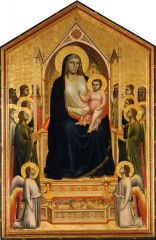
|
Giotto, Oggnisanti Madonna and Child, 1310-1325, commissioned by Ognisanti church, depth shown by saints behind throne, gold background, hierarchical proportion signs of international gothic style, Uffizi Gallery, Florence, compare to Cimabue's Madonna, heaviness and shadow give depth to Mary's body, seems more sculptural than Cimabue's, doesn't use perspective, but viewer feels more there, Giotto gives the viewer a sense of dignity in relation to the divine, painting as a window, traditional medieval use of gold and positioning, shows Mary in heaven but still with us, a major Renaissance theme |
Early 14th Century |
|
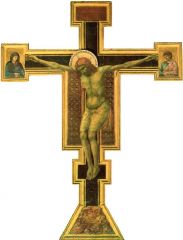
|
Giotto, Crucifixion, 1285-1290ish?, more realistic body of Christ than most depictions at the time, Santa Maria Novella, shift from idealized Byzantine bodies, representing Christ as dead is a modern idea, flowing blood makes Christ seem more human, gateway to Renaissance ideas where humans have more dignity, |
Late 13th Century |
|

|
Giotto, Deposition of Christ, Scrovegni Chapel, early 14th century, biblical setting was Christ being removed from the cross, mirrors Mary's position in Nativity, representing Christ as dead is a modern idea, Christ isn't in center, landscape helps move eye to Christ, dead tree? and analogy to Christ's resurrection, Mary Magdalene at his feet (significant of Bible story), more naturalism, ie. unessesary characters without faces give a sense of space, angels being smaller give a sense of space, blue sky vs. gold sky |
Early 14th Century |
|
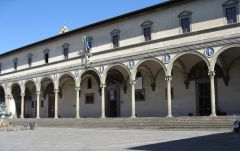
|
Brunellschi, Founding Hospital, Florence, begun 1419, discus influence from Greco-Roman architecture, tondi by della Robbia, composite order columns, most important structure in the beginning of the Renaissance, commissioned by Cosimo de' Medici, made him do the orphanage before the Duomo, ospedale degli Innocenti, each space like a cube since columns were the same length as depth, 9 loggia |
Early 15th century |
|
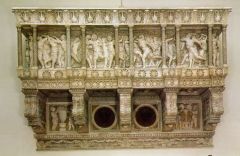
|
Donatello, Singing Gallery, Cantoria, Museo Opero in Florence, 1433-1440, sense of depth provided by columns in front of the putti (fat naked kiddos), compare to della Robbia's singing gallery, influence of ancient Greek and Roman sculpture, unlike Della Robbia's not a sure biblical scene present, Donatello took into account that they would be viewed from the ground and left the sculptures looking rather unfinished. |
Mid 15th Century |
|

|
Donatello, Habakkuk, (Pumpkin Head), Florence, Museo della Opera, 1427-1436, made for Campanile next to Santa Maria dell Fiore, stared down at passersby who nicknamed it, marble, height of Donatello's naturalism in sculpting, psychological realism through facial expression, forewarning prophet, humanism, incites sympathy |
Early-Mid 15th Century |
|
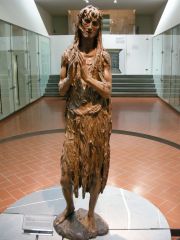
|
Donatello, Mary Magdalene, Museo Opera del Duomo, 1455, wooden, reflects Donatello as he is old and dying too, contrasts of a once beautiful woman, but weathered, clothed in her hair, organic quality of wood is symbolic because wood is also mortal, psychological realism in her expression, incites sympathy, her hands form the church, less anatomically correct, stands in contraposto |
Mid 15th Century |
|
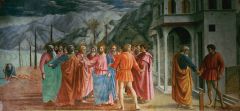
|
Masaccio, Tribute Money, 1425, Brancacci Chapel, Florence, bright colors, use of perspective, Christ being confronted by tax collector (in the short skirt standing in contraposto) they can't pay, but Peter gets it from the mouth of a fish ((give Cesar what is Cesars give God what is Gods)) painted after new tax from Florentine government, eye goes to Christ in the center, atmospheric perspective, deep illusion of space, linear perspective seen with building (one of the first examples of linear perspective, Christ's head is vanishing point), gesturing contrasts, cast shadows!! treating halos as solids, very human, narrative storyline |
Early 15th Century |
|
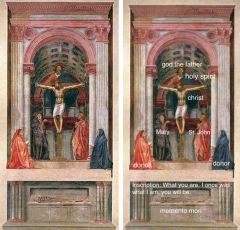
|
Masaccio, Holy Trinity, Santa Maria Novella, 1426-1427, (I was what you are and I am what you will be) Brunellschi's discovery of perspective, vanishing point between the donors, shows God as a man with feet!!- HUMANISM, classical architecture with the columns, first example of 1 point perspective, illusion of space, realistic muscles and blood, skeleton warns to prepare now for death by finding salvation, Mary gestures towards Jesus to show that he is the way towards salvation |
Early 15th Century |
|
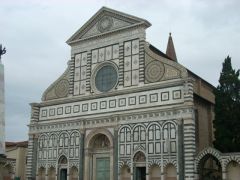
|
Leon Battista Alberti, facade of Santa Maria Novella, 1458-1470, similar colors to baptistery and Santa Maria del Fiore, marble from Carrara, green and white, strong geometric shapes, can be compared to gothic architecture, |
Mid- Late 15th Century |
|
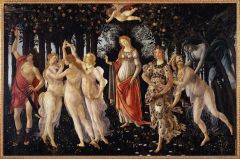
|
Sandro Botticelli, 1482, La Primavera, Uffizi Gallery, Florence, secular/mythical theme, pagan subject, Mars (God of War pushing away clouds) is at peace, 3 graces on the left, Zephyr abducting Cloris (Flora and Cloris are the same person?) Blindfolded cupid (son of Venus) aiming arrow at a grace, long figures typical of Botticelli, traces of atmospheric perspective, translucent dresses, statement about different types of beauty, |
Late 15th Century |
|
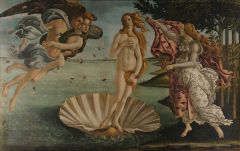
|
Sandro Botticelli, 1484-1490, Birth of Venus, Uffizi Gallery, Florence, strange because nude woman who isn't Eve, based on ancient sculpture of Venus, pushed in on seashell by wind, attendant ready to clothe her, unrealistic pose, very linear painting as subjects are all of the same plane, divine beauty, humanism led to resurrection of nudity, Simonetta, Botticelli's muse was the model for Venus in this painting and springtime |
Late 15th Century |
|
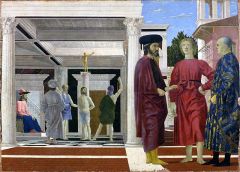
|
Piero della Francesca, Flagellation of Christ, Urbino, National Gallery of the Marche, 1458-1460, oil painting, evidence of Francesca's obsession with perspective, flagellation takes place in the back of the scene whilst figures talk in the front, compares historical events to biblical ones, innovative composition, many different interpretations as to who the three figures are, light coming from christ (or other secondary light source, Christ's body is unharmed and unbloodied, huge sense of depth, Chirst and blond boy are similar, representing death and suffering of blond boy (son of Ottiviano?) |
Mid 15th Century |
|
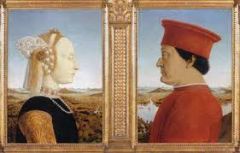
|
Piero della Francesca, Paired Portraits of Frederico Montefeltro and Battista Sforza, oil painting, Florence, Uffizi Gallery, 1472-1474, painted shortly after her death, painted from her death mask?, inspiration from Flemmish painters, atmospheric perspective of Urbino landscape, reference of profile coinage, reverse of the painting has both Battista and Frederico in chariots, surrounded by figures that represent their virtues, ie. justice, |
Mid to Late 15th Century |
|
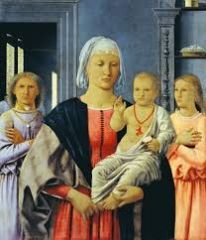
|
Piero della Francesca, Senegallia Madonna, Urbino, National Gallery of the Marche, 1478-1480, background is the inside of the ducal palace, made for wedding of Giovanna Montefeltro, oil painting, red coral on Jesus signifies his suffering, light values |
Mid to Late 15th Century |
|
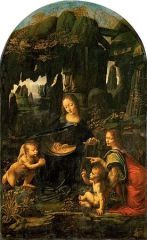
|
Leonardo Da Vinci, Madonna of the Rocks, Louvre, Paris, 1483-1508, atmospheric perspective, interesting background, unique setting and positions of Mary, 2 versions, pyramid composition, typical figures of John the Baptist, Jesus, Mary and an angel, very sweet and graceful virgin, complex pose, stern hand on John's shoulder (directing him towards christ- symbolic!!) SFUMATO, smoky haziness from background, softness and grace, natural accuracy to plants, bodies, and landscape |
Late 15th Century- Early 16th Century (High) |
|
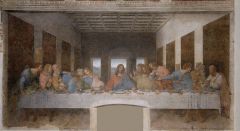
|
Leonardo Da Vinci, The Last Supper, 1494-1498, painted for a refectory (cafeteria for monks) Santa Maria della Grazie (Milan) reactions of all of the apostles, Judas has bag of silver pulling from Christ, reacting to Christ's words saying one will betray him, perspective, sense of space through background, no halos, organized chaos with Christ in the middle forming his own pyramid, window light forming halo, simplified background to put focus on expressions, table as a barrier, Judas in shadow and profile, peter holds a knife as Christ's protector, experimental painting technique left the painting all but ruined |
Late 15th Century |
|
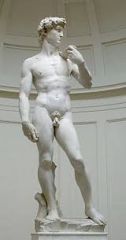
|
Michelangelo, David, 1501-1504, David and Goliath, classical contraposto, idealized body, much of body is relaxed, hand starts to tense, sense that David has just caught sight of Goliath, clear that he understood human body, Galleria della Academia, opposition to tyranny parallel to ideals of republic of Florence, posing refers to classical images of Hercules, male nude = classical antiquity, surpassing ancient Rome, placed in Palazzo Vecchio, city fell in love, symbol of renewed Republic |
Early 16th Century, High Renaissance, |
|
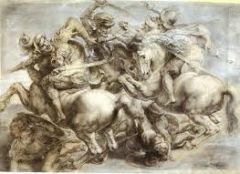
|
Leonardo da Vinci, Battle of Anghiari, sketch for fresco for walls of Palazzo Vecchio in Florence, never completed, 1503, violent clash of men and horses |
Early 16th Century |
|
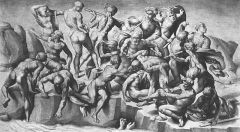
|
Michelangelo, Battle of Cascina, never completed, male nude, studies of bodies, time of relaxing during battle, bathing etc and then being warned that the enemy is approaching, also was to be painted for Palazzo Vecchio, looked like Michelangelo used this as practice for figure drawing |
Early 16th Century |
|
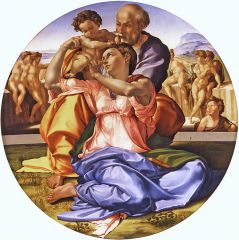
|
Michelangelo, Doni Tondo, Uffizi Gallery, only surviving panel painting by Michelangelo, 1507, cangiantismo, Holy Family (Mary Jesus Joseph in front with John trailing behind) inclusion of classical nude figures behind, pyramidal structure, frame allowed Michelangelo to sculpt, st joseph being higher than mary is odd because usually hireachally Mary is higher, perhaps showing man as head of house, commissioned as wedding gift by Agnolo Doni |
Early 16th Century |
|
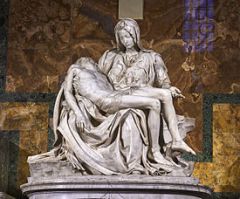
|
Michelangelo, La Pieta, St. Peter's Basilica- 1497-99, Mary holding dead Jesus, pulling off the flesh of Jesus' arms make it look more like flesh than marble, sweetness and beauty vs. her looming largeness, drapery, hierarchal proportion, signed work, displaying Jesus, popular theme through northern Europe |
Late 15th century |
|
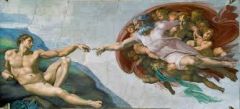
|
Michelangelo, the Creation of Adam, Sistine Chapel, 1508-1512, cangiantismo, God in a brain anatomically correct, book of Genesis, elegance of gestures, muscles, optimism and power of high renassiance, influence from door of paradise touch, humanism, god and man equal sizes |
Early 16th Century |
|
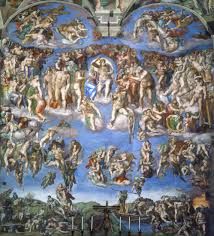
|
Michelangelo, The Last Judgement, 1534-1541, Sistine Chapel, skin is Michelangelo, 20 years post ceiling, shows people being dragged to hell and heaven, Christ in top center, pants added later, seperation theme continues, dense powerful and muscular bodies, "spirits" have density, the damned man- psychological connections, reflects church conflict due to Martin Luther |
Mid 16th Century |
|
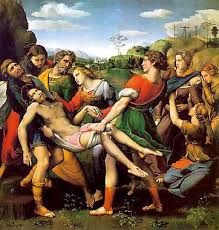
|
Raphael, Entombment of Christ, Borghese Gallery, Rome, 1507, areal perspective, bright colors, strange iconography, |
Early 16th Century |
|

|
Michelangelo, Moses, Rome, 1513, for tomb of Pope Julius the Second, twisting anger and pent up energy for his people have gone against the Lord's commandments, idealized body, detail in beard, dynamic, living, breathing figure |
Early 16th Century |
|
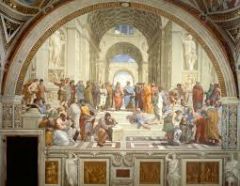
|
Raphael, School of Athens, Museum of the Vatican, 1510-1511, fresco, same time as Sistine Chapel, fitting for an environment of learning, philosophical branch, plato and Aristotle, self portrait, included Michelangelo, Woman looking at us and Raphael looking up, painted many artists as philosophers which might say, "artists are the revolutionary thinkers of today" cangiantismo |
Early 16th Century (High) |
|

|
Bramante, Temppieto, 1502, sight of crucifixion of Saint Peter, circle around the point, papacy goes back to saint peter, also principal architect for st. peter's basilica, roman/greek columns, circular plan, ancient geometry and the design, perfect circle "godlike" |
Early 16th Century |
|
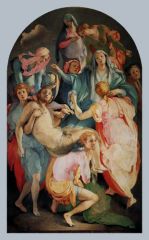
|
Jacopo Pontormo, Entombment of Christ, 1525-28, Mannerist, we don't know exactly the situation because no context of background, distorted posing, weightless bodies, overwrought emotions like masks, art that isn't based on nature |
Early-Mid 16th Century, Mannerist |
|

|
Parmigianino, Madonna of the Long Neck, 1530-33, oddly proportioned Mary, arm of Christ falls in a Pieta way, dead/asleep, art from art vs. art from nature, complicating of the body, absurd size relationships ie. tiny prophet giant virgin |
Mannerist, Early-Mid 16th Century |

